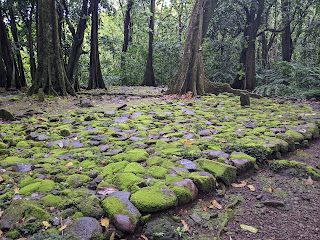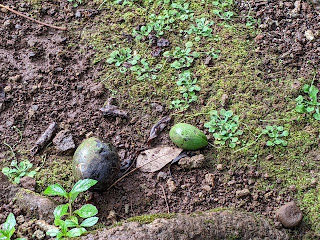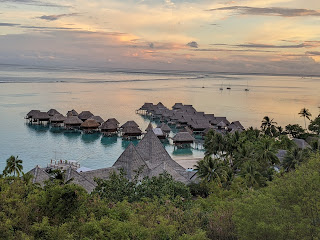On the advice of Cathy, our rental property owner, Steven and I had made timed reservations to take a small motorboat over to Coco Beach on a nearby private island. She thought we'd enjoy the snorkeling and the beach with its own restaurant.
En route to Coco Beach with four others from the mainland:
I wonder if these overwater bungalows had been closed because of an economic downturn as a result of Covid?
Coco Beach dead ahead!
No landing dock on the island although we hadn't known that in advance!
We didn't know when Cathy and her husband, Thierry, had last been over to Coco Beach as our experience there wasn't as positive as theirs must have been. There was a pretty constant parade of noisy boats, the snorkeling was no great shakes compared to the other beaches we'd already been to on Moorea, and there was a limited stretch of beach. However, on a positive note, we didn't see any palm trees and thus falling or fallen coconuts, Phil and Mikaela!
I think the tiny island's vibe was far more appealing to people 30 plus years younger than we are who wanted to participate in lots of drinking rather than water activities. Guess we're getting to be old fuddy duddies!
After just a couple of hours and with dark clouds rolling in, we easily caught a boat back to the mainland as reservations were only needed on the outward route.
We luckily reached our car just minutes before the heavens opened and decided that we might as well take the opportunity to drive around part of the island.
Tiny little grocery stores dotted the island at regular intervals and sold everything from soup to nuts, it seemed.
The marae in Papetoai:
Near Opunohu Bay was the CRIOBE environmental research station.
On the grounds of the research station was a fan tree as you might have guessed!
The Lycee Agricole de Polynesie Francaise aka Moorea's agricultural high school welcomed students from all the islands and had hundreds of hectares planted in pineapples, vanilla, coffee, fruit trees, decorative flowers, and native vegetables on land seized from a German company in 1914.
From the school, we drove a short distance to the largest of a group of Polynesian temples in Opunohu Valley. Surveys and excavations of the valley's temples, houses, and other archaeological sites were conducted beginning in 1960. In the small part of the valley we explored there was a high density of Ma'ohi settlements. The entire valley comprised over 63 house sites, 145 temples and shrines, and thousands of agricultural sites. The Ma'ohi settlement in Opunohu began circa 1250 AD and continued up to European contact in 1767.
A little further along was Marae Titiroa that had been restored in 1969. The marae's small platform or ahu was a sacred area reserved for gods. It was here people offered tubers, fish, dogs, and pigs and prayed to their gods, many of who were deified ancestors.
The stone slabs sticking up in the middle of the marae were backrests for participants of honor.
Just a hundred yards or so from Marae Titiroa was a long council platform or tahua that would have been located within a large ceremonial complex. The platforms were used as assembly places on which chiefs, priests, and warriors held councils or meetings and discussed political, religious, and social issues concerning the life of the community.
A short walk further into the forest were two smaller marae surrounded by towering Tahitian chestnut or mape trees.
The most evocative temple was the four-tiered Marae Ahu o Mahine a little deeper into the forest.
I read that the young leaves of this fragrant ornamental plant were used as perfumes and, when food was scarce in olden times, it was cooked and eaten after being soaked in water.
About our only companions on the trail to the marae were a number of roosters!
The nahe or giant fern:
Several hundred yards up the hill were some stone archery platforms. This is where kneeling nobles once competed to see who could shoot an arrow the furthest. The bows and arrows, however, were never used in warfare.
Archery was reserved for the male elite chiefs, warriors, and landowners. The aim was to shoot further than 240 meters in a carefully cleared shooting corridor. After the arrow was shot, young men stationed on treetops on each side of the corridor would shout, signaling the arrow had just passed by. Several judge-referees would announce the result by waving flags.
The marae near the archery platform was thought to honor the god of archery.
Yikes, this tree with its very twisted branches and pointed leaves was called a reva or suicide tree because its fruit looked like mangoes but contained a violent poison. It was said to have medicinal and magical properties and also used in rituals.
After exploring a good chuck of the valley's archaeological area. I could now appreciate how the valley offered both scholars and visitors alike the opportunity to understand 700 years of Ma'ohi cultural heritage and their interactions with the natural environment!
From the archaeological area, the winding road rose sharply for a mile until we reached Opunohu Lookout. If there's a more stunning view in all of French Polynesia than this lookout near the geographical center of Moorea, I don't think we managed to find it in three weeks touring the islands of Huahine, Raiatea, Bora Bora, and lastly Moorea here!
899-meter-high Roto Nui was once the central core of an island that was once three times as high as it is now.
From the lookout we had an OMG view of Cook's Bay!
My hair was extra-curly that day because of all the humidity.
Another night, another beautiful sunset - this one was from the Toatea Lookout.
The lookout high above the Sofitel Moorea resort honored the victims of a plane crash in which 20 people died in 2007 in the deep passage romantically called the Sea of the Moon between Tahiti and Moorea.
Next post: Exploring more of Moorea by car and jeep, the latter on Pineapple Road!
Posted on February 4th, 2022, from Phoenix, Arizona, as we welcomed our youngest who flew in today from Denver for his 30th birthday weekend.






































































No comments:
Post a Comment